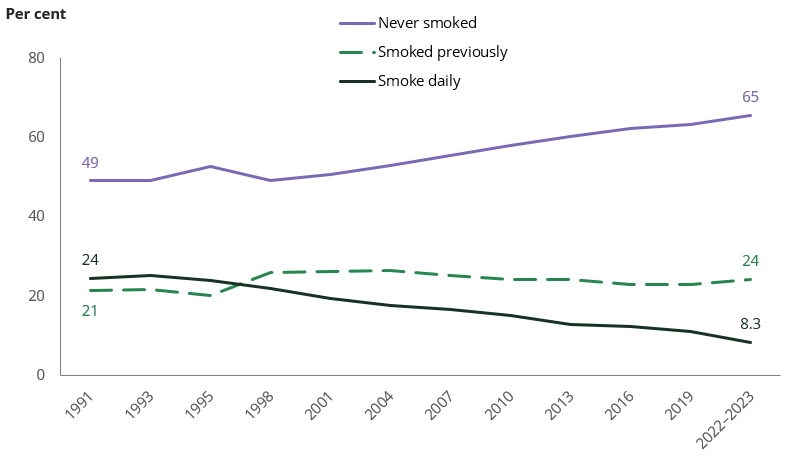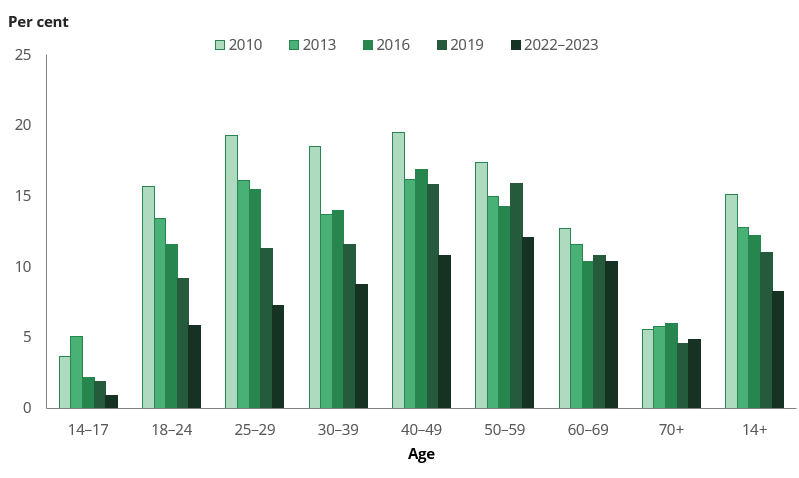ONLY 8.3% OF PEOPLE IN AUSTRALIA NOW SMOKE DAILY
1 in 12 people smoke daily.
The proportion of people aged 14 and over who have ever smoked has declined over the past two decades. In 2001, about one in two (49%) people in Australia had smoked in their lifetime. By 2022–2023, this had reduced to just one in three (35%).
The trend was similar for people who smoked daily. In 2022–2023, 8.3% of people smoked daily, less than half of the 19.4% of people who smoked daily in 2001 and a substantial reduction from 11.0% in 2019 (Figure 1). This equates to about 1.8 million people smoking daily in 2022–2023, a decrease from 2.3 million in 2019.

Who was most likely to smoke?
As in previous surveys, males were more likely to smoke daily (9.0%) than females (7.7%) in 2022–2023. Positively, daily smoking decreased for both males and females between 2019 and 2022–2023, so in both years males were 1.2 times as likely as females to smoke daily.
Between 2019 and 2022–2023, daily smoking decreased among all age groups from 18–24 through to those aged 50–59. Only those aged 60–69 and 70 and older did not see substantial decreases in the daily smoking rate (Figure 2).

As a result, people who smoke were older in 2022–2023 than ever before. 1 in 5 (20%) people who smoke were in their 40s in 2022–2023 (similar to 19.8% in 2001), 19.5% were in their 50s (up from 13.4% in 2001) and 14.4% were in their 60s (up from just 5.8% in 2001).
People who lived in the areas of most socioeconomic disadvantage were the most likely to smoke daily, with 13.4% doing so in 2022–2023. In general, areas with higher socioeconomic advantage had lower proportions of people smoking daily, with the lowest level of smoking prevalence (4.1%) occurring in the areas of most socioeconomic advantage.
Positively, there was a substantial decrease in the level of daily smoking in the most disadvantaged socioeconomic areas between 2019 (18.1%) and 2022–2023 (13.4%). People living in those areas were 3.3 times as likely as those living in the most advantaged socioeconomic areas to smoke daily, down from 3.6 times as likely in 2019 (Figure 3).
There was no change in the daily smoking rate between 2019 and 2022–2023 for people living in Remote and Very remote areas, while reductions occurred in Major cities, Inner regional areas and Outer regional areas. As a result, people living in Remote and Very Remote areas were 2.9 times as likely to smoke daily (20%) as people in Major cities (7.0%), an increase from 2019 when they were 2.0 times as likely to do so.
Considerations for clubs
Several states still allow smoking in outdoor gaming rooms and these rooms often generate significant income. However, with such a small percentage of smokers it is worth keeping an eye on the gaming data. If more than one outdoor area is available it may be time, given the decline in the number of smokers, to consider the benefits of an outdoor non-smoking area.
Source: National Drug Strategy Household Survey 2022–2023: Tobacco smoking in the NDSHS – Australian Institute of Health and Welfare (aihw.gov.au)












